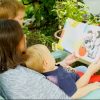A wordless book? Is a book a “real” book if it has no words?
Yes!
A wordless picture book still tells a story.
The pictures communicate the flow of the story without text. The reader tells the story with his own the words.
Benefits of wordless books
When adults read children’s books aloud, we depend on the words as the “script” to tell the story. When the script isn’t there, the attention is on the pictures in a brand new way. There is definitely no skipping over the pictures in a wordless book. It’s not a hurry-up, race-to-read experience.
Think about it from a child’s view point: in books with words the pictures confirm the words he hears and give him more details. In a wordless book, the pictures help him create the words of the story. He becomes a story teller. And you, of course, are there to help.
Some of the benefits for language I see with wordless books:
- A child and an adult are conversation partners to tell the story.
- Ah ha! moments are created when your child “gets” what happened by looking at the pictures and uses his own words to explain.
- Each reading is a new experience– different words can be used to tell the story or additional details might discovered in the pictures.
Wordless books are flexible. You and your child look at the pictures together and simply talk about what you see. There’s not one “right” way to do it.
Wordless books are thinking tools. Ask questions about what the characters are doing–and what they might be thinking or feeling–based on the pictures. What are the clues in the pictures for what might happen next?
Wordless books are language stretchers. Your child may see a picture for which he doesn’t yet have a word. Since the need for the words was already created, when he hears your words to describe the picture, the new words more likely to stick with him.
Where to start
If you ever have a “where do I start” feeling when you pick up a wordless book, here are a few tips:
- Start with the cover and title. Use the clues on the cover and share some guesses what the book will be about.
- Point to each picture as you talk. More than one illustration might be on a individual page, so be clear which picture you talking about.
- Move from main idea to details. Talk first about what is happening, then look again to discover the details.
What if your child doesn’t have anything to say when you read a wordless book together?
Be the model. Talk about the pictures and continue to give opportunities for input.
Bonus: Wordless books work for all home languages. If the local library has only a few selections in the language you’re searching for, using some wordless books may fill the gap. You and your child can tell the story in any language you choose.
Check out these links to find some lists of wordless books to help you get started: Reading Rockets or Goodreads .
Or see these posts (A Ball for Daisy or The Lion & the Mouse) for examples of reading wordless books.
Find a wordless book and get ready to have a conversation with your child!



